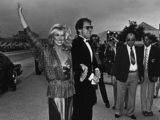
Is Taylor Swift Really the Biggest Diva of the Decade?
December 31, 2019When the American Music Awards crowned Taylor Swift the Artist of the Decade last month, it seemed obvious and promotional: Swift had a new album out and was in the headlines again, fighting to own her music catalogue. But in reality, the award may have been de facto: In a decade defined by pop divas, she was the only one who made it all the way through.
When you think of the female artists of the decade, several power hitters immediately step up to the plate as contenders: Swift, Adele, Beyonc, Katy Perry, Rihanna, Lady Gaga, Ariana Grande.
Thats just based on imperfect hunches. Feelings. Fandom. The sense that their music was always around, following you through grocery stores and car trips and pool parties, or at the very least was important to you. You remember their names in headlines. You have their songs on your workout playlists. You pull up Homecoming on Netflix every time someone gives you the remote at a party.
But Adele is finishing the decade at age 31, meaning its been six years since her last album, 25, took over the music world. And after releasing seven albums in as many years in the first decade of her career, its been so long since Rihanna released ANTI that the wait for a new album has become a meme. Shes even taken to trolling her fans on social media.
Ariana Grande has certainly been around all decade, thanks to child stardom on Nickelodeon and a critically acclaimed first album, Yours Truly. But its only been in the latter half of the 2010s that shes been the force we think of her as now. And Katy Perry, bless her heart, has finished the decade she built on the back of Teenage Dream with a series of well-intentioned flops.
Then theres Beyonc, whose contributions with Lemonade and Homecomingreverberated with such intensity that they disguise the fact that the living legend hasnt been the radio or music charts force that she was in the decade prior.
Taylor Swift and Lady Gaga are the only artists to rank near the top of Billboards year-end charts both in 2010 and 2019. With Gaga, its on the back of her soundtrack work for A Star Is Born, a cultural event that mattered fiercely to the decadeespecially in tandem with the rest of Gagas pop output. But is that same as Swifts sheer longevity? Shes the only female artist to rank near the top of Billboards list every year of the 2010s.
When you look at the arena of pop divadom from the beginning of the decade to now, is influence no longer measured only by how we feel about these artists when theyre in our headphones? After 10 years of these women defining pop culture, but softening the rate of their musical output as their impact grows and their cultural contributions diversify, is divadom now defined by absence?
Its hardly a new phenomenon that, as a singers fame grows, how they satisfy their creative itch and take advantage of the scale of their reach evolves past the act of churning out music.
The path from pop star to Hollywood leading lady is a well-worn one, for example, though Lady Gagas arrival at Oscar nominee is a bit more singular in that regard.
With that as a consideration, then, how does a performer like Jennifer Lopez fit into the conversation of divas of the decade? Few artists wear that term with as much comfort as she does, and her nimble juggling of a music and movie career will pay off with a promising one-two at the beginning of the next decade with a Super Bowl co-headlining slot and award-show recognition for her performance in Hustlers.
And if the success of endeavors outside the music studio contribute to the idea of diva supremacy, then Kelly Clarksons recent crowning as the new queen of daytime TV makes a case for her joining the conversation. And what value, then, is there in judging a show like The Voice or American Idol? (Bolstering Clarksons status, while adding the likes of Christian Aguilera, Alicia Keys, Shakira, Miley Cyrus, Jennifer Hudson, and Gwen Stefani.)
These are things that keep artists on our minds even when theyre not making new music. Rihanna has appeared on nearly as many high-fashion magazine covers in the years since ANTI as the ones before, thanks to the revolutionary success of her makeup and fashion lines. Its a business effort that, in its push for inclusivity in the world of beauty, has made Rihannas impact on culture more valuable than before, and its been entirely independent of musicyet made possible because of it.
Of course, the ways in which a divas presence and celebrity can dictate a cultural revolution is something that Beyonc has considered with fervor this last decade. She entered the 2010s as a pop star, and is exiting a legend very much of her own making: a woman who surveyed her conscience for what mattered and then the landscape, determining how she could use her talent and worth to service the latter.
As much of a lightning rod as she can be, its arguable that Swift has taken this up in her own way as well, selectively speaking out on numerous industry and feminist issues.
These last 10 years, maybe more than any before them, have raised the question of whether being a phenomenal singer, a la Adele, or contributing a dance-floor bop, a la Ariana Grande, is enough anymore. Even doing both while suspended upside down from silks, Cirque du Soleil-style, as Pink made her mark doing, may not be enough. We need the music. We need the vocals. But we also need something more.
As we head into 2020, how do you measure a diva? More, how do you decide who was the biggest one of this past decade?
You could try measuring things empirically. We went through Billboards Artist of the Year chart for the past 10 years and made a spreadsheet of the Top 10 female artists of each year, to get a sense of longevity and dominance.
Lady Gaga, Adele, Taylor Swift, and Katy Perry were the only women to rank No. 1 in any year, with Adele doing it three times. As mentioned before, Lady Gaga and Taylor Swift were the only artists to appear both in 2010s list and 2019s list.
Then, Swift was arguably still a country singer first. She dipped her toe in crossover pop stardom that year with the tail end of Fearless popularity turning You Belong With Me into a phenomenon. Speak Nows release that same year cemented her industry foothold when it made her the youngest Album of the Year winner ever at the Grammys.
Lady Gagas breakout was still mid-rocket launch, with the popularity of her debut, The Fame, lingering as The Fame Monster turbo-boosted her career into the stratosphere.
Swift and Gaga would appear on year-end lists more often than anyone this decade, with Rihanna, Nicki Minaj, Katy Perry, and Ariana Grande joining them on more than half of the decades years. In total, 35 women appeared at least once.
There were women that you likely forgot had years-long spells of relevance, like Meghan Trainor, and others who had concentrated, singular success in a given year, like Sia, Kesha, and, uh, Susan Boyle.
And what of the artists who werent as prolific or constantly dominant, but had bursts of success throughout the entire decade, like Pink, Carrie Underwood, and Miley Cyrus? Or legends who certainly asserted their relevance with solid chart showings throughout the decadeBritney Spears, Madonna, Kelly Clarksonbut whose reputations are more in their legacies than in new chart-topping hits?
The first No. 1 single of the 2010s was Keshas Tik Tok, a petulant, rabble-rousing spoken-sung rebuke of the confines of female and industry propriety. The last is Mariah Careys All I Want for Christmas Is You, a 25-year-old holiday hit from perhaps the most seminal pop diva there ever was, in the traditional sense of the label, indicating perhaps a return to the comfort of those expectations.
Kesha, Katy Perry, Pink, Rihanna, Britney Spears, Lady Gaga, Adele, Kelly Clarkson, Taylor Swift, Miley Cyrus, Lorde, Iggy Azalea, Meghan Trainor, Sia, Cardi B, Camila Cabello, Ariana Grande, Halsey, Billie Eilish, Lizzo, Selena Gomez, and Mariah Carey all had number one songs this last decade.
That list alone is a pretty canny survey of the spectrum of divadom: the blips that break through when we crave a shiny new thing, the veterans who prove their viability decades into their careers with new music, the megastars flexing their muscle, and the new class announcing themselves. But what does it say about the past, and the future?
How much will we value individuality and unique talentwill an artist like Billie Eilish have longevityversus fascination with the stars we already know and love: Could Taylor Swift and Lady Gaga extend their streaks at the top to 2020?
Are new artists already learning the value of standing for something in addition to their musicLizzo seems to certainly get thatand what would our insistence on that mean for a force like Adele, who has managed to pop in every few years, blow our hair back with her vocals, and then disappear again? Will reverence continue to equal relevance?
The likes of Britney Spears, Christina Aguilera, Mariah Carey, Madonna, and more are still in every conversation about current divas, regardless of chart performance. How likely is that to continue?
There are things we could predict for the new decade. Cardi B, Lizzo, Ariana Grande, and Halsey will continue to surge. When Rihanna finally does drop new music, it will be huge. We suspect chart comebacks from Katy Perry and Beyonc, though with the latter it will more likely encompass something more meaningful than that.
If theres something to be gleaned by the biggest divas of the 2010s, its that the title is what you make it. Taylor Swift, Lady Gaga, Beyonc, and Rihannaarguably the four female artists that defined the decadewere able to carve out reigns at the top on their own terms. That didnt always mean through music, but always with the idea of what value there was to their visibility and celebrity.
A solid bop along the way doesnt hurt, too.
Read more: https://www.thedailybeast.com

